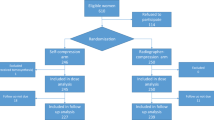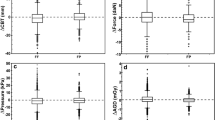Abstract
Objectives
We compared the compression force, breast thickness, and glandular dose, as well as the severity of discomfort and women’s experience between the patient-assisted compression (PAC) and standard compression (SC) modes.
Materials and methods
We conducted a prospective randomized controlled study at Hospital del Mar in Barcelona, Spain. We included 448 asymptomatic women aged 50 to 69 years old, attending their screening round from December 2017 to December 2019. Mammograms included the two bilateral views. In each woman, one breast was studied with SC and the other with PAC. The mode used in each breast was selected following a randomized list. Compression force, breast thickness, and average glandular dose were obtained for each of the 1792 images. We also recorded the degree of discomfort and women’s experience, after mammogram acquisitions, using a predefined survey.
Results
Higher compression forces were obtained with PAC than with SC (99.27 N vs 83.25 N, p < 0.001). Breast thickness mode (56.11 mm vs 57.52 mm, p = 0.015) and glandular dose (1.34 mGy vs 1.37 mGy, p = 0.018) were lower in PAC. The discomfort score was slightly higher with PAC (mean 3.94 vs 3.69, p = 0.042), but in the satisfaction survey, more women reported that PAC caused less discomfort. Additionally, 63.2% of women (289/448) preferred PAC.
Conclusion
PAC achieved higher compression forces without impairing the other technical imaging parameters and enhanced women’s experience of screening mammography. We believe there were no clinically significant differences in the severity of discomfort between the two modes.
Key Points
• Self-compression allows higher compression forces than the standard compression mode.
• Self-compression does not affect technical imaging parameters.
• Self-compression improved women’s experience of screening mammography when standard compression was used on one breast and self-compression on the other.


Similar content being viewed by others
Abbreviations
- CC:
-
Craniocaudal
- kPa:
-
Kilopascals
- mGy:
-
Milligray
- MLO:
-
Mediolateral oblique
- mm:
-
Millimeters
- N:
-
Newtons
- NRS:
-
Numeric rating scale
- PAC:
-
Patient-assisted compression
- PCC:
-
Pearson’s correlation coefficient
- SC:
-
Standard compression
- SD:
-
Standard deviation
References
Sung H, Ferlay J, Siegel RL et al (2021) Global cancer statistics 2020: GLOBOCAN estimates of incidence and mortality worldwide for 36 cancers in 185 countries. CA Cancer J Clin 71(3):209–249. https://doi.org/10.3322/caac.21660
Canelo-Aybar C, Ferreira DS, Ballesteros M et al (2021) Benefits and harms of breast cancer mammography screening for women at average risk of breast cancer: a systematic review for the European Commission Initiative on Breast Cancer. J Med Screen. https://doi.org/10.1177/0969141321993866
Whelehan P, Evans A, Wells M, Macgillivray S (2013) The effect of mammography pain on repeat participation in breast cancer screening: a systematic review. Breast 22:389–394. https://doi.org/10.1016/j.breast.2013.03.003
Bj L, Martin M (1992) Breast pain associated with mammographic compression. Australas Radiol 36(2):120–123. https://doi.org/10.1111/j.1440-1673.1992.tb03095.x
Poulos A, Rickard M (1997) Compression in mammography and the perception of discomfort. Australas Radiol 41(3):247–252. https://doi.org/10.1111/j.1440-1673.1997.tb00668.x
Perry N, Broeders M, de Wolf C, Törnberg S, Holland R, von Karsa L (2008) European guidelines for quality assurance in breast cancer screening and diagnosis. Fourth edition—summary document. Ann Oncol 19(4):614–622. https://doi.org/10.1093/annonc/mdm481
Moshina N, Sebuødegård S, Hofvind S (2017) Is breast compression associated with breast cancer detection and other early performance measures in a population-based breast cancer screening program? Breast Cancer Res Treat 163(3):605–613. https://doi.org/10.1007/s10549-017-4214-8
Holland K, Sechopoulos I, Mann RM, den Heeten GJ, van Gils CH, Karssemeijer N (2017) Influence of breast compression pressure on the performance of population-based mammography screening. Breast Cancer Res 19(1):1–8. https://doi.org/10.1186/s13058-017-0917-3
Poulos A, McLean D, Rickard M, Heard R (2003) Breast compression in mammography: how much is enough? Australas Radiol 47(2):121–126. https://doi.org/10.1046/j.0004-8461.2003.01139.x
Miller D, Livingstone V, Herbison P (2008) Interventions for relieving the pain and discomfort of screening mammography. Cochrane Database Syst Rev 1. https://doi.org/10.1002/14651858.CD002942.pub2
Serwan E, Matthews D, Davies J, Mn C (2020) Mammographic compression practices of force- and pressure-standardisation protocol: a scoping review. J Med Radiat Sci 67(3):233–242. https://doi.org/10.1002/jmrs.400
Feder K, Grunert JH (2017) Is individualizing breast compression during mammography useful?—Investigations of pain indications during mammography relating to compression force and surface area of the compressed breast. Rofo 189(01):39–48. https://doi.org/10.1055/s-0042-119450
Moshina N, Sagstad S, Sebuødegård S et al (2020) Breast compression and reported pain during mammographic screening. Radiography 26(2):133–139. https://doi.org/10.1016/j.radi.2019.10.003
De Groot JE, Branderhorst W, Grimbergen CA, Den Heeten GJ, Broeders MJM (2015) Towards personalized compression in mammography: a comparison study between pressure- and force-standardization. Eur J Radiol 84:384–391. https://doi.org/10.1016/j.ejrad.2014.12.005
Jeukens CRLPN, van Dijk T, Berben C, Wildberger JE, Lobbes MBI (2019) Evaluation of pressure-controlled mammography compression paddles with respect to force-controlled compression paddles in clinical practice. Eur Radiol 29(5):2545–2552. https://doi.org/10.1007/s00330-018-5953-6
de Groot JE, Hopman IGM, van Lier MGJTB, Branderhorst W, Grimbergen CA, den Heeten GJ (2017) Pressure-standardised mammography does not affect visibility, contrast and sharpness of stable lesions. Eur J Radiol 86:289–295. https://doi.org/10.1016/j.ejrad.2016.11.030
Moshina N, Sebuødegård S, Evensen KT, Hantho C, Iden KA, Hofvind S (2019) Breast compression and experienced pain during mammography by use of three different compression paddles. Eur J Radiol 115(2018):59–65. https://doi.org/10.1016/j.ejrad.2019.04.006
Broeders MJM, ten Voorde M, Veldkamp WJH et al (2015) Comparison of a flexible versus a rigid breast compression paddle: pain experience, projected breast area, radiation dose and technical image quality. Eur Radiol 25(3):821–829. https://doi.org/10.1007/s00330-014-3422-4
Kornguth J, Sullivan C, Rimer K, Stout L, Conaway R (1993) Impact of patient-controlled compression on the mammography experience. Radiology 186(1):99–102. https://doi.org/10.1148/radiology.186.1.8416595
Balleyguier C, Cousin M, Dunant A, Attard M, Delaloge S, Arfi-Rouche J (2018) Patient-assisted compression helps for image quality reduction dose and improves patient experience in mammography. Eur J Cancer 103:137–142. https://doi.org/10.1016/j.ejca.2018.08.009
Henrot P, Boisserie-Lacroix M, Boute V et al (2019) Self-compression technique vs standard compression in mammography: a randomized clinical trial. JAMA Intern Med 179(3):407–414. https://doi.org/10.1001/jamainternmed.2018.7169
Ulus S, Kovan Ö, Arslan A, Elpen P, Arıbal E (2019) A new technical mode in mammography: self-compression improves satisfaction. Eur J Breast Health 15(4):207–212. https://doi.org/10.5152/ejbh.2019.4480
Alukic E, Bravhar P, Mekis N (2021) Does the use of self-compression in mammography affect compression force, breast thickness, and mean glandular dose? Eur J Radiol 139:1–4. https://doi.org/10.1016/j.ejrad.2021.109694
Wang X, Ji X (2020) Sample size estimation in clinical research. Chest 158(1):S12–S20. https://doi.org/10.1016/j.chest.2020.03.010
Perez-Leon D, Posso M, Louro J et al (2021) Does the patientassisted compression mode affect the mammography quality? A within-woman randomized controlled trial. Eur Radiol. https://doi.org/10.1007/s00330-022-08834-z
Acknowledgements
We would like to thank all the women participating in the screening program, as well as the epidemiology team, technicians, and radiologists from the PSMAR breast screening program.
Funding
The study received funding from General Electric (GE Healthcare), but the funders had no role in the study design, data collection or analysis, decision to publish, or preparation of the manuscript.
Author information
Authors and Affiliations
Corresponding author
Ethics declarations
Guarantor
The scientific guarantor of this publication is Dr. Margarita Posso.
Conflict of interest
The authors of this manuscript declare no relationships with any companies whose products or services may be related to the subject matter of the article.
Statistics and biometry
Two of the authors have significant statistical expertise.
Informed consent
Written informed consent was obtained from all subjects (patients) in this study.
Ethical approval
Institutional Review Board approval was obtained.
Methodology
• prospective
• randomized controlled trial
• performed at one institution
Additional information
Publisher’s note
Springer Nature remains neutral with regard to jurisdictional claims in published maps and institutional affiliations.
Institution from which the work originated:
IMIM, Hospital del Mar Medical Research Institute, Barcelona, Spain, Passeig Marítim 25-29, Barcelona 08003, Spain
Supplementary information
ESM 1
Supplementary Figure 1. Rigid compression paddles have two different sizes: 24 × 29.8 cm (on the right) and 19 × 23 cm (on the left), suitable for larger or smaller breasts. Supplementary Figure 2. Remote control has two push buttons: an upper one with the + symbol which allows participants to increase compression, and a lower one with the − symbol to reduce compression. Supplementary Table 1. Satisfaction Survey in a study comparing PAC vs. SC. Breast cancer screening program of Hospital del Mar, Barcelona, Spain, 2017-2019. Supplementary Table 2: Compression parameters and discomfort by compression mode stratified by each of the four projections. (DOCX 792 kb)
Rights and permissions
About this article
Cite this article
Arenas, N., Alcantara, R., Posso, M. et al. Comparison of technical parameters and women’s experience between self-compression and standard compression modes in mammography screening: a single-blind randomized clinical trial. Eur Radiol 32, 7480–7487 (2022). https://doi.org/10.1007/s00330-022-08835-y
Received:
Revised:
Accepted:
Published:
Issue Date:
DOI: https://doi.org/10.1007/s00330-022-08835-y




